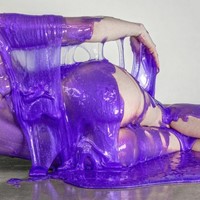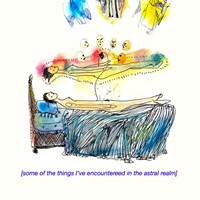ASMR videos are not only relaxing – they’re also a safe space for trans and non-binary viewers to feel affirmed and explore feelings about their gender identity
“Do you want me to do your make-up? I can do your make-up if it will make you feel a little more feminine,” asks Julieta ASMR, in one of her TikTok roleplays where she does the viewer’s make-up to help them feel femme. This particular clip has over 55,000 likes, with a number of comments from grateful viewers. “As a trans girl I love this,” one reads. “I am non-binary and this made me so happy,” says another. “So many sweet heartfelt comments like these make me happy,” Julieta, an inclusive ASMRtist, tells Dazed.
There are a number of gender-affirming ASMR videos just like this scattered across TikTok and YouTube. There’s Gibi ASMR’s ‘getting you ready for Pride’ series, where she refers to the viewer using a variety of pronouns so they can see what ‘clicks’ for them. There are audio-only videos where the ASMRtist pretends to be the viewer’s boyfriend or girlfriend and whispers positive affirmations to soothe their dysphoric feelings. There’s also a whole range of ‘personal attention’ and roleplay videos out there, where ‘your gatekeeping bestie does your make-up’ or ‘the girl in the back of class plays with your hair’. Many of these aren’t specifically designed for trans viewers, but they can still be hugely beneficial – especially when they simulate conventionally ‘feminine’ or ‘masculine’ scenarios or settings that viewers might feel excluded from or curious about, such as your bestie ‘getting you ready for prom’ or a wholesome gym bro ‘giving you a pep talk’.
The term ASMR (which stands for Autonomous Sensory Meridian Response) was first coined back in 2010. It refers to the tingling sensation that people feel on their scalp and spine while listening to certain sounds known as ‘triggers’, such as tapping, scratching, or whispering. It’s relaxing – and for trans viewers, they also have the power to be hugely affirming, act as an aid for anyone who is questioning their gender identity, or help heal a wounded inner child.
It’s unsurprising that trans people are turning to ASMR for therapeutic reasons: in recent years, there’s been an increased focus on the potential health benefits of ASMR. A 2018 study found that ASMR can stimulate the release of oxytocin, AKA the ‘love’ hormone; more recently, a study at Northumbria University found that ASMR has the power to reduce stress and anxiety symptoms.
Julieta says that while she is cis, she can empathise with the trans community. “I came out of the closet as a lesbian when I was 36 years old, so I know what it’s like to live in a way that makes other people uncomfortable,” she says. For Julieta, it’s important to offer ASMR which ensures the trans community has “a safe space where they feel welcomed, included and celebrated”, given the volume of “harassment and hatred” the community has experienced in recent years.
@julieta.asmr This is for my trans women, transfemme, gender queer, gender fluid & questioning viewers 💗🏳️⚧️ you’re loved here. #asmr #asmrmakeup #asmrmakeupapplication #asmrmakeuproleplay #asmrmakeupvideo #makeup #makeupsounds #asmrmakeupsounds #lgbt #transfem #transfemme #genderfluid #genderqueer #genderquestioning ♬ original sound - Julieta ASMR 🍒
Cléo, 29, tells Dazed that growing up, they received “little affection” and felt consistently “isolated” and “othered”, especially with regard to their gender identity. “The boys didn’t see me as a boy, the girls didn’t see me as a girl [...] I didn’t know where I should fit in until my mid-twenties,” they say, adding that they “truly believe ASMR helped” them to understand their identity as a non-binary person. 23-year-old Jewels is also a fan of ASMR, particularly ‘positive reinforcement’ videos. Heather Feather is one of her favourite channels. “Her videos made me feel like I really do belong here as I am, as I want to be, in this journey where I won’t stop changing and growing for a while,” she says.
For Jewels, watching certain ASMR videos can trigger a sense of gender euphoria – she says she “absolutely adored” Gibi’s Pride series. “ASMR absolutely helps affirm my gender. Sometimes I just need to hear that I’m a girl.” For Jewels, hearing herself referred to using ‘she/her’ pronouns can help her get a sense of “direction” whenever she feels lost or dysphoric. “When I hear something I identify with, it clicks immediately,” she continues.
Speaking to Dazed, Gibi says she was trying to make content which made viewers feel “happy and comfortable” about their gender while filming the Pride series. “I love seeing that my videos have resonated in some way,” she says. “It’s important to me to have the trans community in mind when I’m filming any immersive content – so it makes me happy when it reaches that audience.” As she has a fluid relationship with her own gender and uses pronouns interchangeably, she adds that she has found creating ASMR helpful in terms of exploring her own identity too. “Making videos in which I presented as masculine or intentionally creating non-binary characters has helped affirm how I feel,” she says.
Jewels also says that she enjoys ‘feminine’ roleplays – like Julieta’s popular ‘femme make-up’ video – or videos where the ASMRtist pretends to be a big sister helping you choose your outfit. “It feels like I’m experiencing something I always wanted to experience, and I wake up thinking more about what I wear and how I want to be seen. It helps me be the person I want to be.”
Cléo has felt similarly while watching roleplay videos, especially ‘makeover’ ASMR clips. “It was like having that ‘make-up friend’ I never got to have as a teen,” they say. “I had enough of a facsimile to gather my thoughts on how those things would make me feel – and it felt good. It felt like I could lay claim to an aspect of femininity, that rite of passage, that was withheld from me.”
They explain that in their view gender is “a constant internal dialogue, a series of questions you pose to yourself day to day”. With this in mind, it makes perfect sense that ASMR is an ideal, safe outlet for people to explore evolving feelings about gender identity. “If you watch a make-up POV video and you’re able to say ‘hey, this was weird for me and I don’t like it’ to yourself, then make-up probably is not a gender-affirming thing for you,” Cléo explains.
“But if you have questions, you’re in this immersive, virtual setting, where a kind and patient person is doing your make-up – which many see as a formative and necessary feminine right of passage,” they continue. “If you decide that this is a thing that moved you… it’s only happened for you. It’s only inside your head. The secret is safe with you.”
Trans and gender non-conforming people can also keep returning to ASMR videos again and again, if needed – something which is both private and free. “You don’t have to buy a bunch of make-up, shave off all your body hair, have someone try your new pronouns – and have them promise not to mention it again if it doesn’t work for you,” Cléo says. By watching ASMR, they say, “you can continue to ask these questions and have this dialogue on your own until you’re ready to escalate.”
All too often, the world can be a difficult place to be trans – which makes it even more important that inclusive ASMR communities exist. Sure, as Cléo says, it’s no replacement for real-life social connection. “Those creators are not my friends, they don’t know me, and I’m under no parasocial delusions,” they say. “But that doesn’t stop the fact it’s emotionally resonant. Everyone’s cried at a movie, right? You can enjoy the fiction – then if you need to later on, you can extract your facts.”
Join Dazed Club and be part of our world! You get exclusive access to events, parties, festivals and our editors, as well as a free subscription to Dazed for a year. Join for £5/month today.




